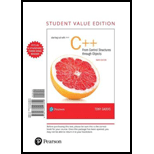
Starting Out with C++ from Control Structures to Objects, Student Value Edition (9th Edition)
9th Edition
ISBN: 9780134443829
Author: Tony Gaddis
Publisher: PEARSON
expand_more
expand_more
format_list_bulleted
Concept explainers
Textbook Question
Chapter 20.2, Problem 20.4CP
What is the difference between direct and indirect recursion?
Expert Solution & Answer
Want to see the full answer?
Check out a sample textbook solution
Students have asked these similar questions
What is the difference between direct and indirect recursion?
A recursion that never ends is defined as follows: What exactly is a direct recursion, and how does it work? An indirect recursion is a kind of recursion that works in a certain way.
Define the term recursion.
Chapter 20 Solutions
Starting Out with C++ from Control Structures to Objects, Student Value Edition (9th Edition)
Ch. 20.2 - What happens if a recursive function never...Ch. 20.2 - What is a recursive functions base case?Ch. 20.2 - Prob. 20.3CPCh. 20.2 - What is the difference between direct and indirect...Ch. 20 - What is the base case of each of the recursive...Ch. 20 - What type of recursive function do you think would...Ch. 20 - Which repetition approach is less efficient, a...Ch. 20 - When should you choose a recursive algorithm over...Ch. 20 - Explain what is likely to happen when a recursive...Ch. 20 - The _____________ of recursion is the number of...
Ch. 20 - Prob. 7RQECh. 20 - Prob. 8RQECh. 20 - Prob. 9RQECh. 20 - Write a recursive function to return the number of...Ch. 20 - Write a recursive function to return the largest...Ch. 20 - #include iostream using namespace std; int...Ch. 20 - Prob. 13RQECh. 20 - #include iostream #include string using namespace...Ch. 20 - Iterative Factorial Write an iterative version...Ch. 20 - Prob. 2PCCh. 20 - Prob. 3PCCh. 20 - Recursive Array Sum Write a function that accepts...Ch. 20 - Prob. 5PCCh. 20 - Prob. 6PCCh. 20 - Prob. 7PCCh. 20 - Prob. 8PCCh. 20 - Prob. 9PCCh. 20 - Prob. 10PCCh. 20 - Prob. 11PCCh. 20 - Ackermanns Function Ackermanns Function is a...
Additional Engineering Textbook Solutions
Find more solutions based on key concepts
Charge Account Validation Create a class with a method that accepts a charge account number as its argument. Th...
Starting Out with Java: From Control Structures through Data Structures (3rd Edition)
(Modified Compound-Interest Program) Modify the application in Fig. 5.6 to use only integers to calculate the c...
Java How to Program, Early Objects (11th Edition) (Deitel: How to Program)
What will the following program segments display? a) for (int count = 0; count 6; count++) System.out.println(...
Starting Out with Java: Early Objects (6th Edition)
What is the advantage of using different types of cursors?
Database Concepts (8th Edition)
(Continuously compounded interest) Suppose that you discover in your attic an overdue library book on which you...
Differential Equations: Computing and Modeling (5th Edition), Edwards, Penney & Calvis
What is a recursive algorithms base case? What is the recursive case?
Starting Out with Java: From Control Structures through Objects (6th Edition)
Knowledge Booster
Learn more about
Need a deep-dive on the concept behind this application? Look no further. Learn more about this topic, computer-science and related others by exploring similar questions and additional content below.Similar questions
- How does the concept of recursion work in computer programming?arrow_forwardWhat precisely does it imply when someone refers to something as a "ForkJoinTask"? How is RecursiveAction distinct from RecursiveTask, and what are some of the ways in which these two concepts are comparable to one another?arrow_forwardDifference between tail recursion and non tail recursion in tabular form with example.arrow_forward
arrow_back_ios
SEE MORE QUESTIONS
arrow_forward_ios
Recommended textbooks for you
 C++ Programming: From Problem Analysis to Program...Computer ScienceISBN:9781337102087Author:D. S. MalikPublisher:Cengage Learning
C++ Programming: From Problem Analysis to Program...Computer ScienceISBN:9781337102087Author:D. S. MalikPublisher:Cengage Learning

C++ Programming: From Problem Analysis to Program...
Computer Science
ISBN:9781337102087
Author:D. S. Malik
Publisher:Cengage Learning
Computational Software for Intelligent System Design; Author: Cadence Design Systems;https://www.youtube.com/watch?v=dLXZ6bM--j0;License: Standard Youtube License